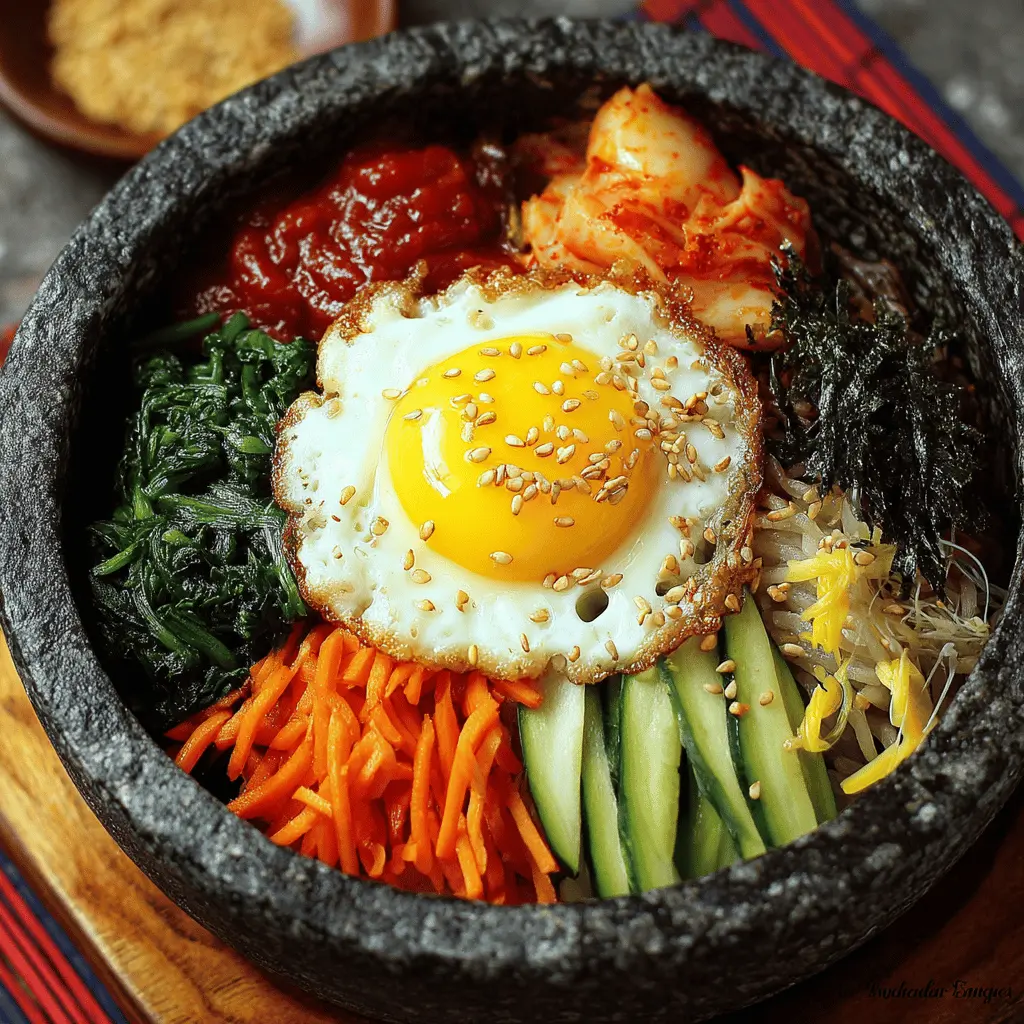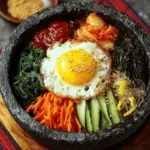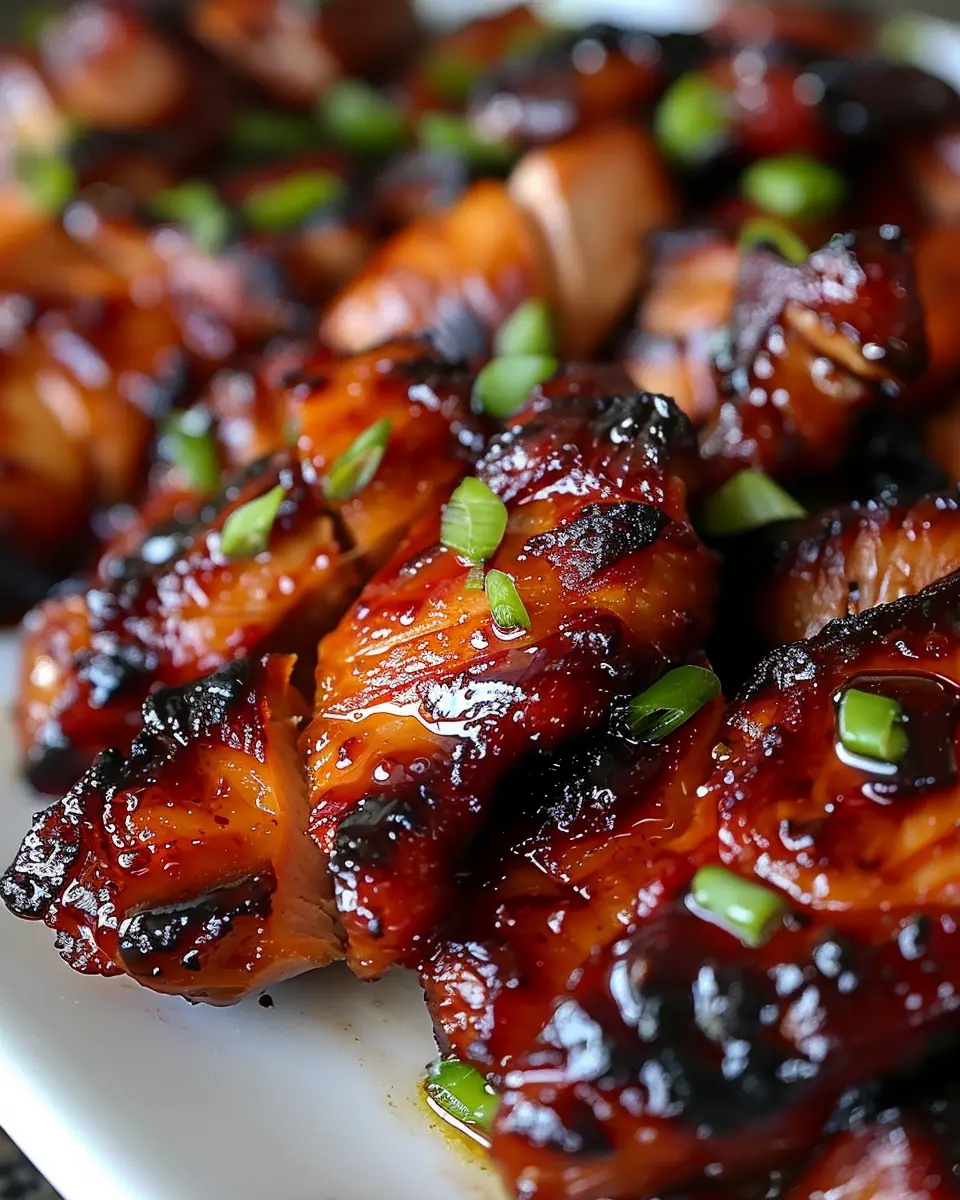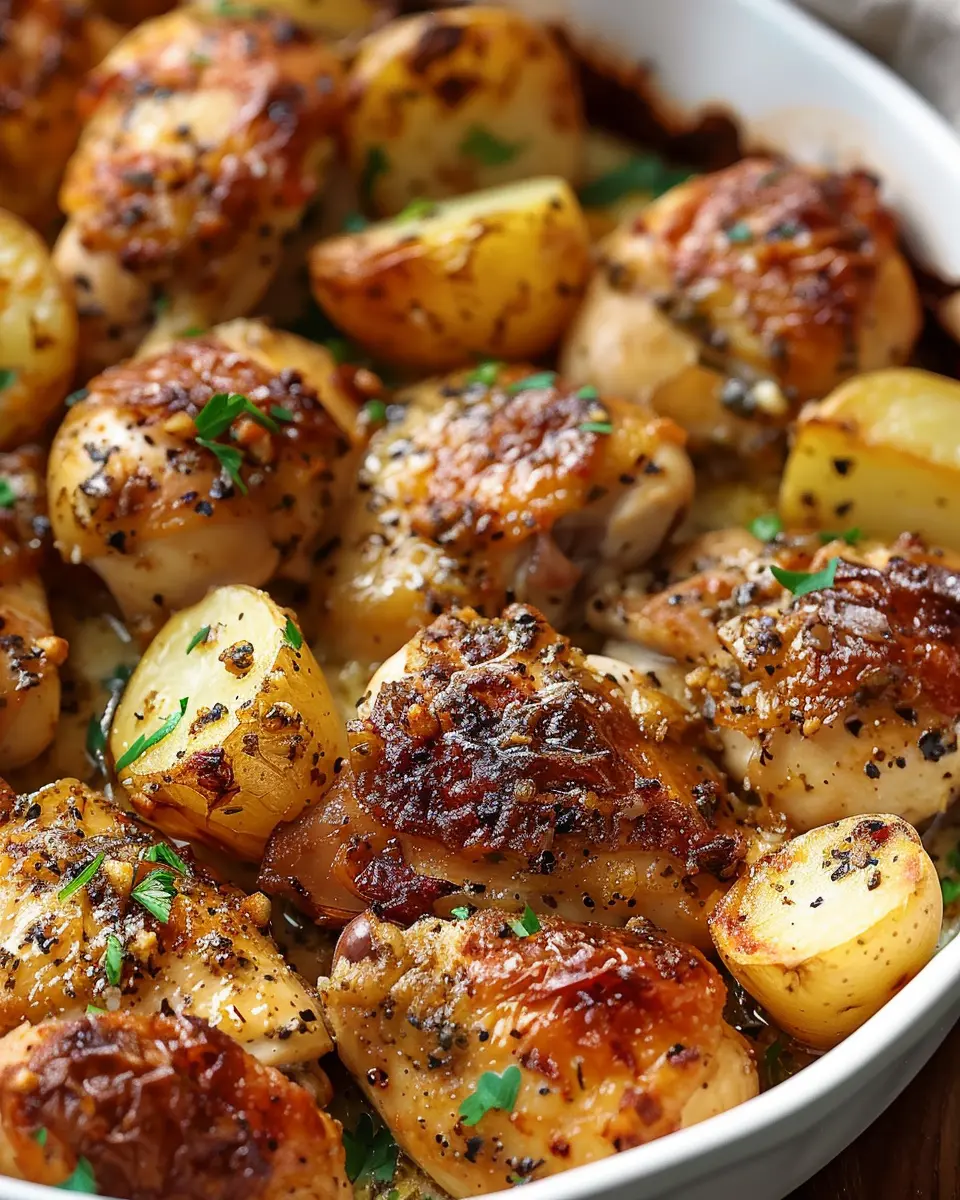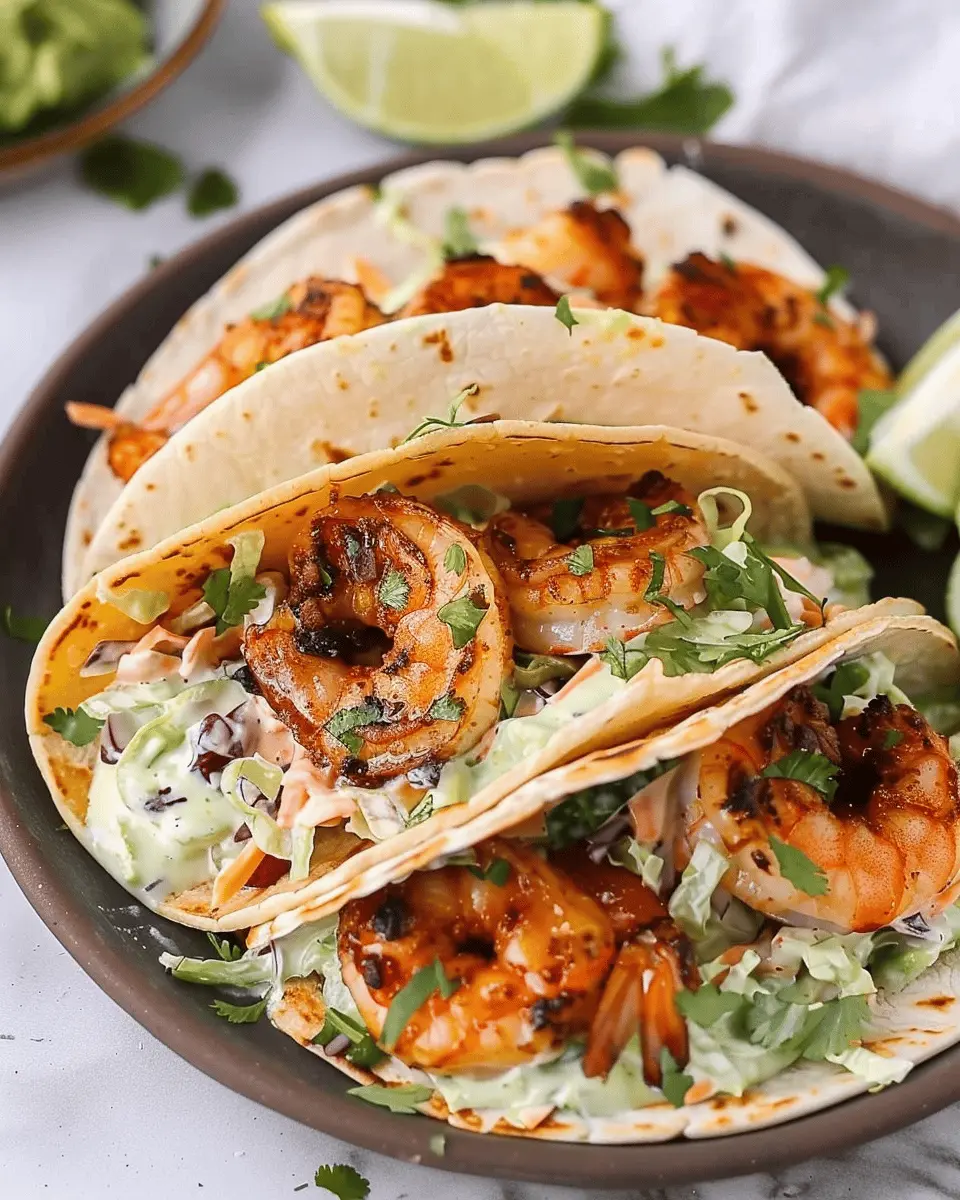Introduction to Dolsot Bibimbap
Discovering the richness of Korean cuisine
If you’ve ever ventured into the world of Korean cuisine, you’ve likely encountered the vibrant and delicious dish known as bibimbap. Dolsot Bibimbap, or stone pot bibimbap, takes this traditional meal to new heights, combining flavors, textures, and a fun serving method that makes it a favorite among many food enthusiasts. This culinary delight is not just a meal; it’s an experience that showcases the richness of Korean food culture.
The essence of Dolsot Bibimbap lies in its harmonious blend of ingredients — a medley of vegetables, protein, and rice, all beautifully arranged and typically topped with a spicy gochujang sauce. The stone pot, or dolsot, adds a unique twist; it retains heat exceptionally well, creating a satisfying crispy layer of rice at the bottom. It’s that perfect crunch that fans of this dish rave about!
Whether you’re cooking for yourself or impressing friends, Dolsot Bibimbap allows for creativity. You can fill it with your choice of protein, from beef to chicken ham or even use Turkey bacon for a twist. Adding seasonal vegetables like zucchini, spinach, and carrots creates a colorful and nutritious composition. According to KoreanBapsang, the fresh ingredients not only taste great but also provide your body with essential vitamins and minerals.
When you sit down to enjoy your Dolsot Bibimbap, you might find yourself faced with a delicious dilemma: should you mix it all together and embrace the glorious chaos, or savor each ingredient separately? The answer often lies in personal preference, but many agree that mixing allows for the full explosion of flavors in every bite.
Like many traditional recipes, Dolsot Bibimbap has roots steeped in history and is often served during celebrations, making it a splendid addition to your culinary repertoire. It’s not just food; it’s a connection to a rich tradition. So gather your ingredients, prepare to create a culinary masterpiece, and dive into the flavors of Korea with this delightful dish!
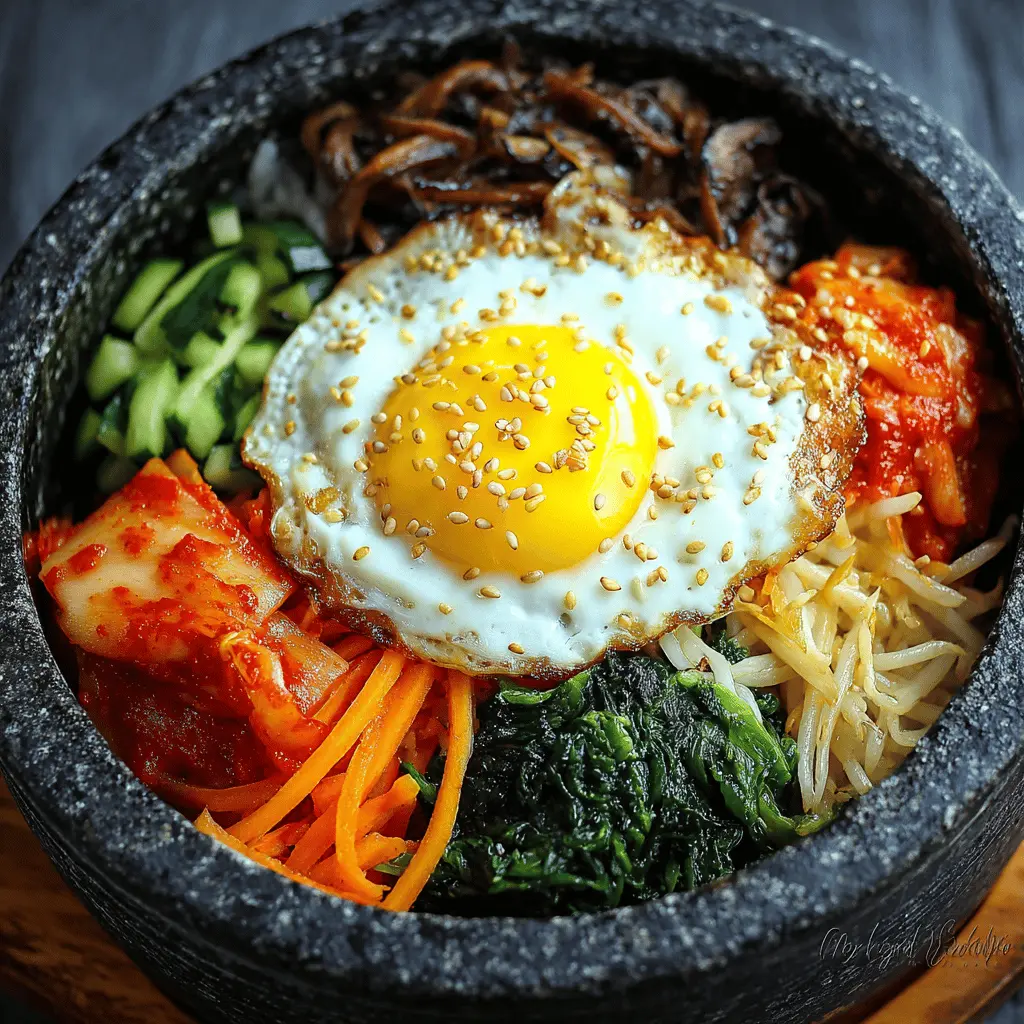
Ingredients for Dolsot Bibimbap
Essential Ingredients
When crafting a Dolsot Bibimbap, the magic truly lies in the fresh and vibrant ingredients you choose. Here’s a sample of what you’ll need to make this delightful dish:
- Short-grain rice: This is the base of your bibimbap; it’s sticky enough to hold all the toppings together.
- Vegetables: Include a colorful mix like spinach, zucchini, carrots, and mushrooms. Each adds its own unique flavor and crunch.
- Protein: For a delicious twist, use lean beef, turkey bacon, or even chicken ham for a lighter option.
- Eggs: Traditionally, a sunny-side-up egg tops the dish, adding richness and creaminess.
- Gochujang: This Korean chili paste provides a bit of heat and depth of flavor, so don’t skimp!
Optional Ingredients for Variations
Experimenting is part of the fun! Here’s how to customize your Dolsot Bibimbap:
- Other proteins: Feel free to add tofu or grilled chicken for a vegetarian or leaner option.
- Additional toppings: Try adding sesame seeds, seaweed, or even radish for extra texture and flavor.
- Sauces: A drizzle of soy sauce or sesame oil can elevate your dish nicely.
Don’t hesitate to get creative! For more inspiration about ingredients, you can check out this guide on Korean cuisine.
With these essentials, you’re well on your way to creating a tasty and fulfilling Dolsot Bibimbap that can become your new go-to comfort food!
Preparing Dolsot Bibimbap
Creating a delicious bowl of Dolsot Bibimbap is not only a delightful culinary task but also a way to engage with the vibrant flavors and textures that traditional Korean cuisine has to offer. Follow these steps for a mouth-watering experience that you can share with friends at home or enjoy on a cozy night in.
Making the Gochujang sauce
The foundation of flavor in Dolsot Bibimbap lies in the Gochujang sauce. Preparing this can be easier than you think! You will need:
- 3 tablespoons of Gochujang (Korean chili paste)
- 1 tablespoon of sesame oil
- 1 tablespoon of sugar or honey
- 1 tablespoon of rice vinegar (for a tangy note)
- 1 teaspoon of minced garlic
Simply whisk all these ingredients together in a bowl until well combined. Gochujang provides a robust, spicy kick, while the sesame oil offers a warm, nutty flavor. You can always adjust the sweetness or spice level to suit your taste. This sauce will bring your Dolsot Bibimbap to life!
Marinating your protein
Next, it’s time to choose and marinate your protein. Popular options include Turkey Bacon, Chicken Ham, and even tofu for a plant-based twist. For optimal flavor, consider these simple steps:
- Mix the following marinade:
- 2 tablespoons of soy sauce
- 1 tablespoon of sugar
- 1 tablespoon of sesame oil
- 1 tablespoon of minced garlic
- Cut your protein into bite-sized pieces and marinate for at least 30 minutes (or longer, if you have time).
Marinating not only infuses your protein with flavor but also tenderizes it. Curious about the benefits of marinating meats? Check out this informative article for more insights.
Preparing the vegetables
While your protein is soaking up those flavors, turn your attention to the vegetables. Colorful, fresh vegetables will enhance both the visual appeal and taste of your Dolsot Bibimbap. Here are some common choices:
- Spinach
- Carrots (julienned)
- Zucchini (sliced)
- Shitake mushrooms or shiitake substitutes
- Bean sprouts
Blanch or lightly sauté these vegetables in sesame oil until tender yet still crisp. This step not only enhances the colors but also brings out the flavors beautifully.
Cooking the protein
Once marinated, it’s time to cook your protein. Heat a non-stick pan over medium-high heat and add a touch of oil. Sauté your Turkey Bacon or Chicken Ham until fully cooked and slightly crispy. If you’re using tofu, ensure it’s golden brown for that satisfying texture. This part should only take about 5-8 minutes!
Assembling the bibimbap in the stone pot
Now comes the fun part: assembling your Dolsot Bibimbap! Heat your stone pot over medium-low heat and add a little oil to coat the bottom. Start layering:
- Rice (cooked short-grain, preferably)
- Your sautéed vegetables
- Cooked protein
This assembly allows the rice to crisp up a bit against the sides of the hot stone pot, adding an amazing texture you won’t want to miss!
Cooking the egg
Traditionally, Dolsot Bibimbap is topped with a fried egg to enhance the richness of flavors. Heat a small amount of oil in a pan and fry your egg sunny-side up or to your liking. Don’t forget, the runny yolk, when mixed, creates a luscious sauce throughout the dish!
Final assembly and serving
To serve, place the hot stone pot directly onto a heatproof surface. Crack the cooked egg on top, drizzle more Gochujang sauce, and garnish with sesame seeds and sliced scallions. Voila! You now have a fragrant, colorful Dolsot Bibimbap ready to impress. Remember, often the best meal is shared, so don’t hesitate to invite friends over for a bibimbap night!
Enjoy your culinary journey with this delightful dish!
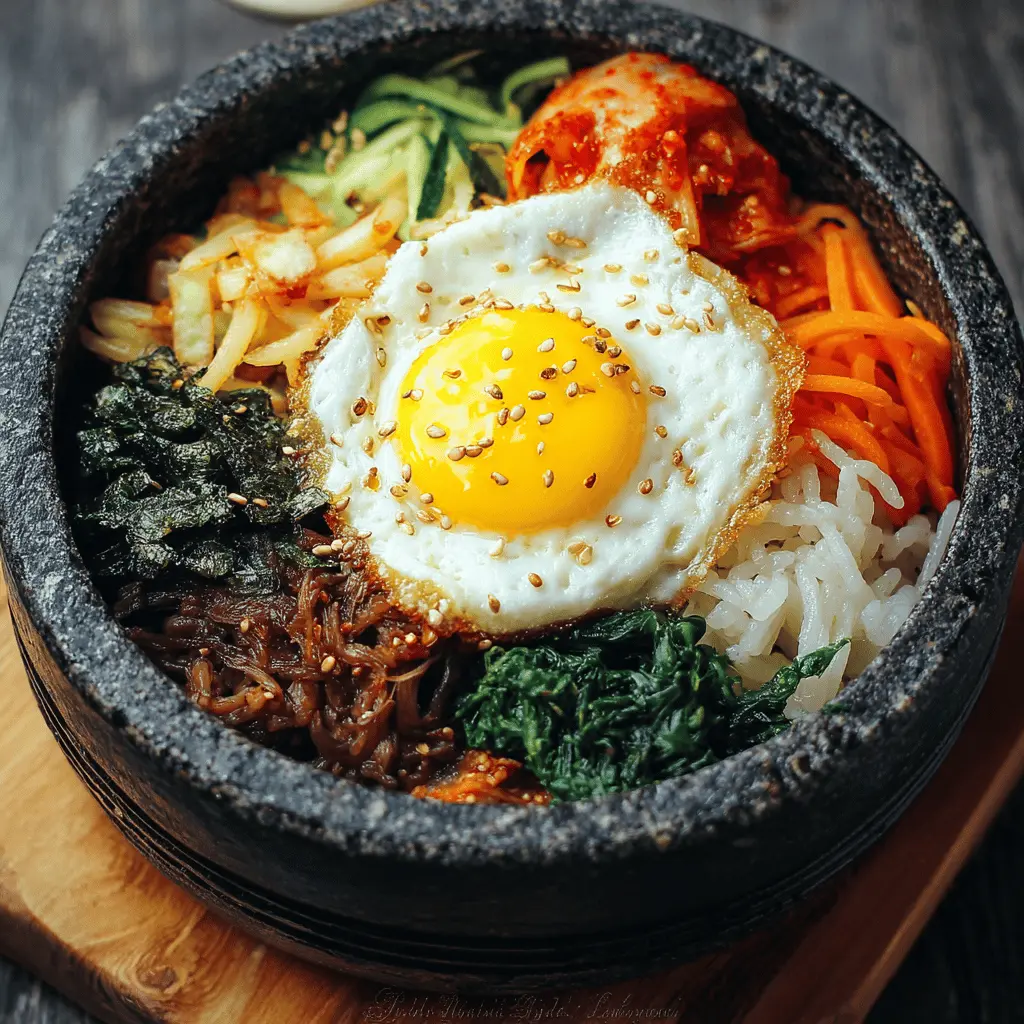
Variations on Dolsot Bibimbap
Dolsot Bibimbap is not just a dish; it’s a delightful canvas where creativity meets tradition. You can easily adapt this beloved stone pot meal to fit personal tastes or dietary preferences. Let’s explore some fantastic variations!
Vegetarian Dolsot Bibimbap
For those embracing a plant-based lifestyle, Vegetarian Dolsot Bibimbap is a game-changer. Replace meat with a vibrant mix of colorful vegetables like bell peppers, spinach, and zucchini. Tofu is a great protein substitute; simply sauté it until golden for added texture. For an extra layer of flavor, incorporate a rich soy sauce or sesame dressing. If you’re curious about the benefits of vegetarian diets, check out this insightful article from Healthline.
Spicy Dolsot Bibimbap
If you’re craving a kick, Spicy Dolsot Bibimbap is the way to go! Start by adding gochujang (Korean chili paste) to your rice and vegetables, stirring thoroughly to infuse that spicy goodness throughout. You can also mix in some sliced jalapeños or drizzle sriracha on top. The heat level can be tailored to your preference, making it as mild or fiery as you like!
Unique Protein Options
Dolsot Bibimbap can include an array of proteins beyond the traditional options. Consider swapping in Turkey Bacon or Chicken Ham for a twist that satisfies both flavor and nutrition. For a seafood variation, grilled shrimp or diced fish add a fresh dimension to this classic dish. With these choices, each bite bursts with unique flavors!
When crafting your own Dolsot Bibimbap, remember that experimentation is key. Play with spices, sauces, and textures to discover what truly tickles your taste buds. Happy cooking!
Cooking notes for Dolsot Bibimbap
Choosing the Right Vegetables
When crafting your Dolsot Bibimbap, the right vegetable selection can elevate your dish from good to unforgettable. While traditional veggies like sliced cucumbers, carrots, and spinach are fantastic staples, feel free to get creative! Consider adding bell peppers for a sweet crunch or sliced radishes for a peppery kick. Seasonal options like asparagus or zucchini can also brighten up your bowl and keep the flavors fresh.
Gluten-Free Options
For those on a gluten-free diet, don’t worry—you can still enjoy this delightful Dolsot Bibimbap. Just ensure that your gochujang (Korean chili paste) is gluten-free, as some brands may contain wheat. Additionally, opt for tamari instead of soy sauce, which is typically gluten-free. With these simple swaps, everyone in your circle can partake in this delicious feast!
For more ideas on gluten-free cooking, check out Celiac Disease Foundation.
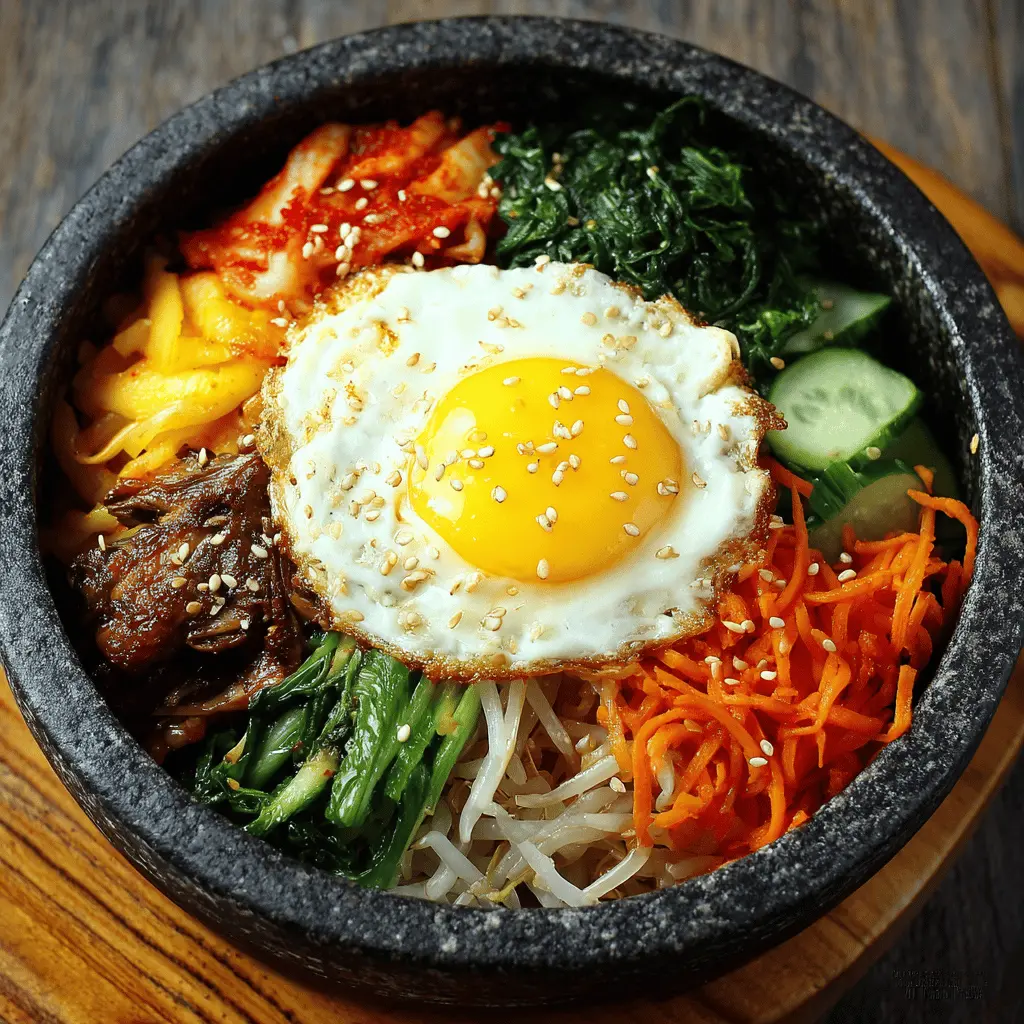
Serving suggestions for Dolsot Bibimbap
Perfect pairings
Dolsot Bibimbap is a versatile dish that shines on its own, yet there are some fantastic accompaniments that can elevate your meal. Consider adding a side of Korean pickled radish (danmuji) for a tangy crunch, or some kimchi for an extra kick. For a lighter touch, a refreshing cucumber salad complements the rice and veggies beautifully. And if you’re looking for a cozy drink to sip alongside, a steaming cup of barley tea makes for a perfect pairing.
Creative serving ideas
When it comes to serving your Dolsot Bibimbap, presentation is key. Here are a few ideas to make it visually stunning and appetizing:
- Layer it up: Arrange ingredients in colorful sections within the stone pot for a feast that’s as pleasing to the eye as it is to the palate.
- Interactive dining: Set up a DIY bibimbap bar allowing guests to customize their bowls with various toppings, such as thinly sliced turkey bacon or chicken ham.
- Spoil the senses: Serve in individual stone pots to create that delightful sizzling sound as the rice crisps against the pot, enhancing the eating experience.
Experimenting with these ideas can make your Dolsot Bibimbap meals not just satisfying but also memorable. Check out more serving suggestions here!
If you want to learn about the health benefits of the ingredients, a comprehensive review can be found in this article.
Tips for Making Perfect Dolsot Bibimbap
Creating an unforgettable Dolsot Bibimbap experience combines technique and ingredients. Let’s dive into a couple of key tips to elevate your dish!
Ensuring the Rice is Crispy
A signature element of Dolsot Bibimbap is that delightful crispy rice at the bottom. To achieve this:
- Preheat the stone pot: Before adding anything, heat your dolsot (stone pot) on medium-high for a few minutes. This step is crucial; a hot pot ensures crispy rice.
- Use short-grain rice: Opting for short-grain rice will yield the stickiness needed to crisp without burning. Give your rice a rinse to remove excess starch for the best texture.
As you spoon in the cooked rice, don’t overcrowd the pot. Leave some room for hot air to circulate, promoting that coveted crunch.
Mixer’s Guide for Sauce
The right sauce can make or break your Dolsot Bibimbap. Create a simple yet flavorful sauce by mixing:
- 2 tablespoons of gochujang
- 1 tablespoon of sesame oil
- 1 tablespoon of soy sauce
- 1 teaspoon of sugar
- 1 teaspoon of vinegar (rice or apple cider)
Feel free to adjust ingredients based on your taste preference. For a tangy twist, consider adding a splash of citrus juice!
Don’t forget, this dish is all about balance. Taste your sauce to ensure it complements the warm ingredients of your bibimbap.
By following these tips, you’ll be well on your way to creating a mouthwatering Dolsot Bibimbap that impresses guests and satisfies your cravings. For more on Korean cuisine, check out Kimchi 101 for expert insights!
Time details for Dolsot Bibimbap
Preparation time
Getting started on your Dolsot Bibimbap is a breeze! The prep usually takes about 20 minutes. This is the perfect time to chop your vegetables, marinate your proteins, and get everything organized. Why not put on your favorite music and enjoy the process?
Cooking time
Once everything is prepped, the cooking process typically spans around 15–20 minutes. You’ll want to cook those vibrant veggies and proteins to perfection while your stone pot heats up. And let’s be real—there’s something so rewarding about hearing that sizzle when you add everything to the pot!
Total time
In total, you’re looking at about 35–40 minutes from start to finish. This makes Dolsot Bibimbap a fantastic option for a weeknight dinner that feels special without consuming your entire evening. For more tips on cooking times, check out Serious Eats, a reliable resource for all your culinary questions!
Nutritional information for Dolsot Bibimbap
Dolsot Bibimbap is not just a delicious meal; it’s also a balanced choice packed with nutrition. Here’s a quick breakdown of its key nutritional components:
Calories
A serving of Dolsot Bibimbap typically contains around 500 to 600 calories, depending on the toppings and portion size. This makes it a satisfying yet manageable option for lunch or dinner.
Protein
You’ll get a hearty dose of protein in Dolsot Bibimbap, primarily from the beef and any additional proteins like chicken ham or turkey bacon you might choose to add. On average, expect about 20 to 25 grams of protein per serving, perfect for fueling your active lifestyle.
Sodium
One thing to note is the sodium content, which can range between 800 to 1,200 mg per serving. To keep it on the healthier side, consider using less soy sauce or opting for low-sodium alternatives.
For a more in-depth look at nutritional values, check out this resource on healthy eating. It’s all about finding that delicious balance!
FAQs about Dolsot Bibimbap
Can I use brown rice instead of white?
Absolutely! You can swap out white rice for brown rice in your Dolsot Bibimbap. While brown rice brings a nuttier flavor and more fiber to the dish, keep in mind that it does take longer to cook. You might want to soak the brown rice before cooking to help with the texture. Many people who try this variation love the additional health benefits without sacrificing too much taste!
How do I store leftovers?
Storing leftovers from your Dolsot Bibimbap is a breeze. Here’s what you need to do:
- Cool down: Let the dish cool to room temperature before storing.
- Container: Divide the leftovers into airtight containers. This keeps the veggies and rice fresh.
- Refrigerate: Store in the fridge for up to 3 days.
When you’re ready to enjoy your leftovers, reheat in a skillet to get that crispy bottom again, or in the microwave if you’re short on time. Just remember to add a splash of water to prevent it from drying out!
What are the best side dishes?
Pairing your Dolsot Bibimbap with side dishes can enhance your meal. Here are a few popular options:
- Kimchi: The classic fermented side that adds a zing.
- Pickled Vegetables: These offer a crunchy contrast.
- Korean Pancakes: A savory treat that complements the main dish beautifully.
These sides not only celebrate the flavors of Korean cuisine but also make your meal feel complete. Consider checking out more on Korean side dishes for inspiration!
Now, with these FAQs, you’ll be all set to enjoy your Dolsot Bibimbap and impress your friends with your new culinary skills!
Conclusion on Dolsot Bibimbap
Embracing homemade Korean delights
In wrapping up your journey with Dolsot Bibimbap, it’s clear that this vibrant dish offers both flavor and comfort. Preparing it at home not only engages your culinary skills but also provides a delightful way to enjoy a hearty meal. The layers of rice, vegetables, and toppings like Turkey Bacon and Chicken Ham create a colorful presentation that’s perfect for sharing with friends.
By embracing homemade Korean delights, you’re investing in quality meals while exploring the rich flavors of Korea. So why not invite some friends over for a cooking session? For more authentic recipes, check out resources from Korean Bapsang or Maangchi. Happy cooking!
PrintDolsot Bibimbap: The Best Recipe for a Hearty Homemade Feast
A delicious and hearty recipe for Dolsot Bibimbap, perfect for a homemade feast.
- Prep Time: 20 minutes
- Cook Time: 15 minutes
- Total Time: 35 minutes
- Yield: 2 servings 1x
- Category: Main Dish
- Method: Stovetop
- Cuisine: Korean
- Diet: Vegetarian
Ingredients
- 1 cup cooked rice
- 1/2 cup sliced carrots
- 1/2 cup zucchini, julienned
- 1/2 cup spinach
- 1/2 cup mushrooms, sliced
- 2 eggs
- 2 tablespoons gochujang (Korean chili paste)
- 1 tablespoon sesame oil
Instructions
- Heat a dolsot (stone pot) over medium heat.
- Add a bit of sesame oil to the pot.
- Place the cooked rice at the bottom of the pot and let it sizzle.
- Layer the vegetables on top of the rice.
- Cook an egg sunny-side up in a separate pan.
- Once the vegetables are cooked, place the egg on top.
- Serve with gochujang on the side.
Notes
- For extra flavor, add some kimchi as a side.
- Adjust vegetables based on seasonal availability.
Nutrition
- Serving Size: 1 bowl
- Calories: 600
- Sugar: 2g
- Sodium: 800mg
- Fat: 20g
- Saturated Fat: 3g
- Unsaturated Fat: 10g
- Trans Fat: 0g
- Carbohydrates: 90g
- Fiber: 3g
- Protein: 15g
- Cholesterol: 200mg
Keywords: Dolsot Bibimbap, Stone Pot Bibimbap, Korean recipes

